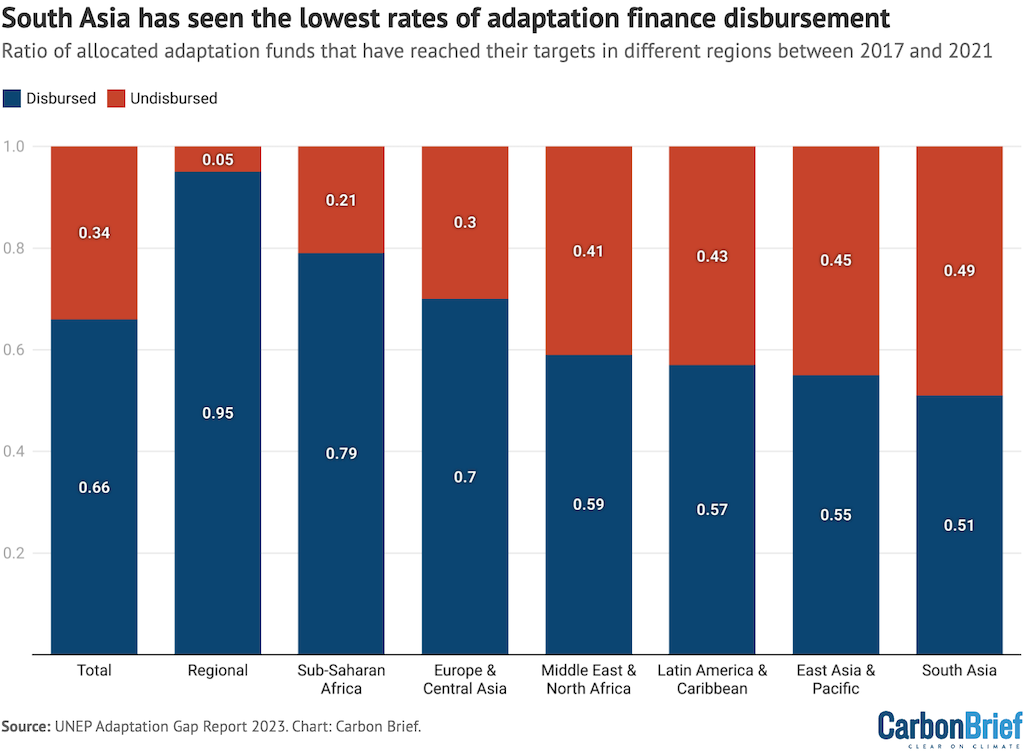Finance
Guest post: Three major gaps in climate-adaptation finance for developing countries – Carbon Brief

Developing countries require hundreds of billions of dollars in investment every year to help them adapt to the rising threat of climate change.
Without this investment, more extreme floods, fires and hurricanes will place many more lives at risk and millions of people in the global south will be pushed into extreme poverty.
Yet, as it stands, there are major gaps in global adaptation finance.
In the new Adaptation Finance Gap Update, part of the UN Environment Programme (UNEP) Adaptation Gap Report 2023, we examine recent trends in adaptation funding.
Specifically, we focus on the flow of public adaptation funds from the governments of developed countries to developing countries, since the implementation of the Paris Agreement.
In this article, we identify three major gaps in adaptation finance and explain why these gaps have emerged even as nations commit to scaling up these funds.
Financial shortfall
Adaptation costs for developing countries are estimated at between $215bn and $387bn annually this decade, according to the latest Adaptation Finance Gap Update report.
Spending from the public funds of developed nations, while not the only source of adaptation finance, remains a crucial source, especially for low-income countries.
As it stands, people in the least developed countries (LDCs) and small-island states are often more exposed to climate hazards and more likely to be killed by climate-related disasters. This is despite the fact that these nations bear very little responsibility for causing climate change.
Under the Paris Agreement, developed countries agreed to achieve a balance in the amount of climate finance to adaptation and mitigation. However, far more funds have been channelled towards cutting emissions than preparing for climate impacts.
The commitments made by developed countries so far fall drastically short of the costs and needs expressed by developing countries.
Observed flows of public adaptation finance from these nations have been well below $30bn each year.
At the COP26 climate summit in Glasgow, developed countries pledged to double their adaptation finance contribution by 2025. However, as the chart below shows, progress towards this goal has fluctuated since the baseline year of 2019 (figures are not yet available for 2022 and 2023.)
In 2019, adaptation finance was estimated in our analysis at $19.2bn. To meet the commitment of doubling this amount by 2025, developed countries should aim to contribute at least $38.4bn per year toward developing countries.
However, a promising 31% increase in funding observed in 2020 was followed by a subsequent 15% decrease in 2021, complicating the path to achieving the target. It is noteworthy that while adaptation finance declined, finance for mitigation – that is, cutting emissions – continued to grow.
To reach the goal of doubling the finance, a consistent 16% average annual increase is required going forward.
Lack of local finance
Local organisations, people and communities are at the forefront of experiencing climate change impacts. Often, they are the most engaged and innovative in developing sustainable solutions to navigate these challenges.
Therefore, it is critical that these local entities are meaningfully involved in funded adaptation projects. However, there has been a lack of clarity on how much adaptation funding is intentionally directed to benefit local communities.
Our analysis provides comprehensive estimates of adaptation finance that mainly focuses on local communities, which cover both bilateral and multilateral sources.
Previous assessments have only covered dedicated climate funds such as the Green Climate Fund (GCF), the Adaptation Fund and the Global Environmental Facility (GEF). Despite their significance, these sources still only constitute a minor share – roughly 9% – of total public adaptation finance.
Our assessment reveals that less than 17% of total international public adaptation finance was allocated to projects with a specific focus on local communities.
Even though this represents an increase from a previous estimate of about 10%, it underscores a persistent and pressing need to increase financial support to local communities.
Struggling to reach the ground
Effective use of funds is essential to ensure that they serve their intended purpose, rather than inadvertently creating new challenges.
However, our research reveals that a significant portion of funding does not even reach its target.
Between 2017 to 2021, we estimate that only 66% of the allocated funds were successfully disbursed to their recipient countries. The remaining funds have not reached developing countries, for various reasons including project delays and lack of capacity.
In contrast, 98% of general development finance, covering other issues such as education and healthcare, was successfully disbursed within the same period.
This highlights the unique barriers in disbursing funds for adaptation projects. These include inadequate understanding of local markets during project planning, limited climate policy knowledge among decision-makers and bureaucratic delays in fund approval and disbursement.
The adaptation disbursement gap varies regionally. South Asia received merely 51% of allocated funds, whereas sub-Saharan Africa, home to most LDCs, had a higher disbursement ratio of 79%.
This discrepancy is likely due to sub-Saharan Africa receiving a higher amount of grants, which tend to have better disbursement ratios.

It is essential to note that these figures predominantly represent data from bilateral sources, meaning funding provided country-to-country.
Comprehensive data on disbursements from multilateral organisations, including the World Bank and other development banks, remains limited. This is significant as most (61%) international public adaptation finance for the global south comes from these sources.
Moving forward
Our analysis shows that adaptation finance goes beyond being a single aggregate number and requires alignment with local situations.
It also indicates that a collaborative approach involving both finance providers and recipients is required to identify and solve existing gaps.
Bridging these gaps could drive a shift towards climate justice, wherein vulnerable, developing countries are not excessively burdened by climate change. Conversely, neglecting them could exacerbate loss and damage in those countries.
Negotiations at the upcoming COP28 in the United Arab Emirates (UAE) present an opportunity for world leaders to establish measures to address these gaps.
Sharelines from this story

Finance
Treasury Department to Use ‘Automation and Innovation’ to Fight Illicit Finance

The Department of the Treasury has outlined the priorities it will pursue this year to step up the fight against illicit finance.
The agency aims to increase transparency, leverage partnerships and support responsible technological innovation, it said in a Thursday (May 16) press release announcing the publication of its “2024 National Strategy for Combating Terrorist and Other Illicit Financing.”
One of the Department’s priorities for the year is closing legal and regulatory gaps in the country’s anti-money laundering and combating the financing of terrorism (AML/CFT) framework, according to the release. It aims to do so by operationalizing the beneficial ownership information registry; finalizing rules covering the residential real estate and investment advisor sectors; and assessing the vulnerability of other sectors.
A second priority is promoting a more effective and risk-focused AML/CFT regulatory and supervisory framework for financial institutions, the release said. The Department will work to do so by providing clear compliance guidance, sharing information and providing resources for supervision and enforcement.
The Department also aims to enhance the operational effectiveness of law enforcement, other U.S. government agencies and international partnerships to combat illicit finance, per the release.
The fourth priority announced in the press release is realizing “the benefits of responsible technological innovation” by developing new payments technology, supporting the use of new mechanisms for compliance, and using automation and innovation to find new ways to fight illicit finance, the release said.
“In this critical moment for our national and economic security, we need to continue to close the pathways that illicit actors seek to exploit for their schemes,” Brian E. Nelson, Under Secretary of the Treasury for terrorism and financial intelligence, said in the release. “We recognize the threat illicit financial activity represents to our national security, economic prosperity, and our democratic values, and are focused on addressing both the challenges of today and emerging concerns.”
These recommendations are meant to address key risks the Department of the Treasury identified in February in its “2024 National Money Laundering, Terrorist Financing, and Proliferation Financing Risk Assessments.”
In another recent move, the Treasury Department said in April that it wants more tools to curb terror financing.
In testimony released ahead of an April 9 appearance before the Senate Banking Committee, Deputy Secretary Wally Adeyemo said terrorist groups and state actors continually “seek new ways to move their resources in light of the actions we are taking to cut them off from accessing the traditional financial system.”
For all PYMNTS B2B coverage, subscribe to the daily B2B Newsletter.
Finance
The Great Financial Crisis kick started the private credit boom, but SVB was its true 'watershed' moment, Sixth Street co-president says

The Global Financial Crisis threw millions of Americans out of their homes and jobs, upending the entire economy. But for the private credit industry, it was actually an awakening of sorts.
Over the past few decades, U.S. banks’ problems have signaled opportunity for the private credit market, and that’s particularly true of the Global Financial Crisis and the collapse of Silicon Valley Bank last March. When banks have issues, U.S. businesses’ desire for capital rarely wanes dramatically, and that leaves room for alternate lenders.
At the Fortune Future of Finance conference on Thursday, Joshua Easterly, co-CIO and co-president of the global investment firm Sixth Street, explained how he was working at Goldman Sachs after the Global Financial Crisis in 2009, running a team that did public and private market transactions in distressed debt and special situations, when he came to the realization that the lending industry had changed forever.
“It was the intended consequence, not the unintended consequence of regulations after the Crisis,” he said of the private credit boom. “Policymakers…wanted to figure out how to diffuse risk away from the taxpayer, but you couldn’t crush the economy by reducing credit, and so private credit history grew.”
Easterly argued that the private credit industry has a “better model” than the banking industry when it comes to lending risk, because it holds more capital for loans on balance sheets. And that made him come to a startling realization in 2009. “Huh? I think I need to go find a new job,” he recalled saying to a colleague. “So [the move to private credit] was a little bit about necessity.”
Carey Lathrop, partner and chief operating officer of credit at Apollo Global Management, echoed Easterly’s comments, noting that when he started in the private credit industry “it was clear how hard it was to get things done that made economic sense” in public markets after the GFC.
The rise of private credit since 2008 has been historic, to say the least. Before the crisis, there was under $400 billion in total assets and committed capital in private credit. In 2023, that number jumped to $2.1 trillion, according to the International Monetary Fund. But it wasn’t just the Crisis that spurred the private credit boom. After the collapse of several regional banks in March 2023, headlined by the tech startup focused Silicon Valley Bank, businesses nationwide once again turned to private credit amid a liquidity crunch.
While SVB struggled after rapidly rising interest rates devalued its long-dated bonds, leading to a run on deposits from its list of influential and well-connected clientele, the manner in which private credit operates can lead to more stability in trying times.
Apollo’s Lathrop explained that banks like SVB “had this mismatch with a lot of long-term assets with assets with short term liabilities” that led to unrealized loan losses on their books as rates soared. But private credit doesn’t have this same issue. “We don’t run the [private credit] business that way,” he noted. “We were much more match funded.”
To his point, unlike banks, which fund a majority of their lending through customer deposits (and often uninsured deposits), private credit funds tend to use money from wealthy investors and institutions to make loans, leaving them less exposed to rising interest rates.
Sixth Street’s Easterly said the SVB drama essentially showed “the robustness” of the private credit] business model, leading a raft of new clientele. “I think it was a watershed moment for the value of the asset class.”
Finance
Four Factors That Impact Your Financial Plan

There’s four factors that may impact your financial plan.
While every financial plan and individual is unique, the core basis of how financial plans work is fairly similar. The good news is that there’s only a handful of data points that will really impact your financial plan, however that is also the bad news, because there’s only a few data points that will truly impact your financial plan.
Your Life Expectancy
How long you live is likely the most impactful data point in your financial plan. After all, what you’re planning for is to not run out of money after you retire, so you need to anticipate how long that period after retirement until the end of your life will last. In general, the population is living longer and this can have an impact on your finances as you may have to plan for a longer lifespan. While your life expectancy isn’t entirely under your control, you can take steps to live healthy lifestyle.
Your Spending
Your expenditures clearly impact your financial plan – if you imagine a group of ten individuals with the same income level and same assets, they’d likely all have different expenditures and would likely all have different success rates in retirement. When you’re thinking about how much money you’ll truly need to retire, that answer depends on how much you’ll planning on spending during retirement – if you’re a low spender, obviously you won’t need as much as someone who is used to spending more in their lifestyle. You’ll also need to account for unknown expenditures, such as healthcare and potential long-term care in retirement, when thinking about your potential expenses. The good news here is that your spending is an area within your control, but it can be difficult.
Your Saving
On the flip side of spending is saving, and your ability to save absolutely impacts your financial plan. The people who prioritize saving generally have an easier time hitting their retirement goals, and the sooner you start the easier it may be to get there.
Minor Factors
While your life expectancy, spending and saving are the main factors that can impact your financial plan, there are several minor factors at play that can influence your plan. Inflation can certainly influence your plan, and this is out of your control. How your investments are structured, by your risk tolerance, may impact your financial plan, and this not only impacts your plan but is within your control. How much money you earn throughout your life impacts your plan, as it obviously allows for you to save more (but potentially also spend more) as you increase your earning potential.
While you can’t control everything that impacts your financial plan, there’s a lot than you can control, and much of it you can get help with through a professional such as a financial advisor.
Financial planning and Investment advisory services offered through Diversified, LLC.
Diversified is a registered investment adviser, and the registration of an investment adviser does not imply any specific level of skill or training and does not constitute an endorsement of the firm by the SEC.
A copy of Diversified’s current written disclosure brochure which discusses, among other things, the firm’s business practices, services and fees, is available through the SEC’s website at: www.adviserinfo.sec.gov.
Diversified, LLC does not provide tax advice and should not be relied upon for purposes of filing taxes, estimating tax liabilities or avoiding any tax or penalty imposed by law. The information provided by Diversified, LLC should not be a substitute for consulting a qualified tax advisor, accountant, or other professional concerning the application of tax law or an individual tax situation.
Nothing provided on this site constitutes tax advice. Individuals should seek the advice of their own tax advisor for specific information regarding tax consequences of investments. Investments in securities entail risk and are not suitable for all investors. This site is not a recommendation nor an offer to sell (or solicitation of an offer to buy) securities in the United States or in any other jurisdiction.
-

 Politics1 week ago
Politics1 week ago'You need to stop': Gov. Noem lashes out during heated interview over book anecdote about killing dog
-

 News1 week ago
News1 week agoMan, 75, confesses to killing wife in hospital because he couldn’t afford her care, court documents say
-

 Politics1 week ago
Politics1 week agoRFK Jr said a worm ate part of his brain and died in his head
-

 World1 week ago
World1 week agoPentagon chief confirms US pause on weapons shipment to Israel
-

 Politics1 week ago
Politics1 week agoHere's what GOP rebels want from Johnson amid threats to oust him from speakership
-

 World1 week ago
World1 week agoPro-Palestine protests: How some universities reached deals with students
-

 World1 week ago
World1 week agoConvicted MEP's expense claims must be published: EU court
-

 Politics1 week ago
Politics1 week agoCalifornia Gov Gavin Newsom roasted over video promoting state's ‘record’ tourism: ‘Smoke and mirrors’

/cdn.vox-cdn.com/uploads/chorus_asset/file/24805888/STK160_X_Twitter_006.jpg)











